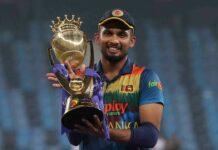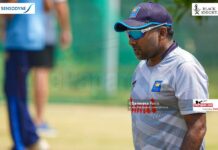“Fear is part of people’s life. Some of them don’t know how to face it, others – where I include myself – learn coexisting with it or face it, not as a negative thing, but like a auto-protection sensation” – Ayrton Senna
It wasn’t a surprise when the Brazilian once again took the pole position and this time at his hometown, Sao Paulo. But the two-time and reigning world champion had one worry, he was yet to win in Brazil. The 71-lap, 307km race was nearing its end and with 7 laps to go, Senna’s gearbox was falling apart. Having lost the 4th gear at the beginning, with couple of laps left, he had also lost the 3rd and the 5th. However, a failed gearbox or the deteriorating weather couldn’t stop the extraordinary and determined driver as he completed the race using only the 6th gear to claim his first win at home.
The struggle of trying to keep the car under control caused him to have muscle cramps, fever and severe exhaustion. He was taken to the podium by medics, amidst the boisterous chants “Ole Ole Ole Ole Senna! Senna!….” from a packed crowd at Interlagos. The 1991 Brazilian GP was already history; a win for Brazil as much as for Senna, with more emotions than a man could bear.
Ayrton Senna’s magic on the track hypnotized audiences. His exceptional triumphs at the wheel of a racing car earned him 3 staggering World Championships, 41 Grand Prix victories, 65 pole positions and 80 podium finishes. His numerous records aren’t even half the story. His outstanding pole positions, thrilling drives through dire weather conditions and phenomenal victories delighted the spectators. His extreme passion for intense driving and endless self-persuasion to extend his limits to go faster than himself, made the Brazilian maestro perhaps the most charismatic, enigmatic and insanely talented driver ever to grace Formula 1.
Ayrton Senna da Silva was born on March 21, 1960 into a wealthy family in Sao Paulo. At the age of 7, Senna first learned to drive a Jeep and entered Karting competitions when he was 13. The teenager didn’t have idols, but admired work, dedication and competence. In 1978, he entered the Karting World Championships. His first rival was team-mate Terry Fullerton, who later Senna felt that he got the most satisfaction driving against. “It was pure driving, pure racing. There wasn’t any politics, any money involved either, so it was real racing” Senna once stated. After competing in British F3 Championships, in 1983 Senna was tested for F1 teams but neither Williams nor McLaren offered him a race. However he made his debut with Toleman in 1984 at the Brazilian GP. At Monaco, in unceasing rains, Senna recorded the fastest lap time and was only second to his future rival Alain Prost which sent a message of the sensational talent the youngster possessed.
In 1985, with ambitions sky-high, Senna signed with Lotus. It was an immediate success. In the second race of the season, Senna recorded his first win at Portugal under worse conditions than Monaco a year earlier. His Lotus 97T grabbed the eye, defying the weather gods in charming style. He lapped every car but one. After his debut win, Senna mentioned, “Winning is like a drug. It is something so strong and so intense, that once you experience it, you keep searching for it all the time”. One more victory was followed in the Belgian GP as Senna concluded the 1985 season with 2 wins. His 7 pole positions for the season underlined his status as the sport’s foremost qualifier.
Senna’s exceptional talent at qualifying spoke for itself as he earned the pole positions of the first three races during the 1986 championship. Although the opener at Brazil was won by fellow countryman Nelson Piquet, Senna bounced back, securing the Spanish Grand Prix three weeks later. One more win at Detroit, allowed him to finish the season with 2 wins and 8 pole positions.
The following season in 1987 became the turning point in his life. Senna managed to successfully defend his title at Detroit GP and emerged victorious for the first time at the iconic Monte Carlo circuit in Monaco. Senna finished the season strongly, becoming runner-up in the final two races in Japan and Australia. But post-race scrutinizing in Japan found the brake ducts of his Lotus to be wider than it was allowed by the rules. He was ultimately disqualified, bringing his last and most successful season with Lotus to a fretful end. Senna ended up third in the final standings, with 57 points, six podium finishes and one pole position. However long before the end of the 1987 season, McLaren made their move to capture both Senna and Honda’s engines. Melded with Prost, now a two-time world champion and a formidable design team spearheaded by Gordon Murray and Steve Nichols, the team was unstoppable.
The 1988 season was memorable, not only because Ayrton Senna bagged his first Formula 1 title, but also because the enthralling season laid the foundation for a fierce rivalry between Senna and Prost. While the pair seized 15 wins out of 16, the McLaren – Honda team amassed a massive 199 points to win the Constructors’ Championship, 134 points ahead of its closest competitor Ferrari. However Senna’s winning season got off to a disappointing start in Brazil, where he was disqualified on a technicality. And although he won for the second time at Imola, victory at Monaco was secured by Prost, as a result of him crashing into the barriers during lap 67. The Canadian Grand Prix at Circuit Gilles Villeneuve reflected his implacable dominance as Senna grabbed the pole position, fastest lap, as well as the win. At Silverstone, Prost withdrew stating that the conditions were too dangerous to drive, but Senna’s wet weather zest saw him triumph again in wretched conditions. The title seemed to be slipping from Senna’s grasp when he stalled on the grid at Suzuka but uncompromising Brazilian came back from the 16th position to win the race and seal his World Championship. The Brazilian bettered the Frenchman by winning 8 races which included four wins in a row and an astounding 13 pole positions. Following the success, Senna said, “You will never know the feeling of a driver when winning a race. The helmet hides feelings that cannot be understood”.




















